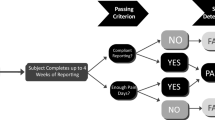Abstract
Recent literature supports the efficacy of multidisciplinary pain management in treating persons suffering from chronic pain. However, the components of multidisciplinary pain management need to be evaluated in terms of effects on patients' quality of life as well as saving of future health care dollars. Therefore, cost-effectiveness of three treatment groups was compared by examining treatment outcome, posttreatment health care costs, and posttreatment health care visits. Results revealed that patients receiving both medical and psychological treatment (multidisciplinary pain management) exhibited the largest improvements in functional capacity, while being the least costly after their treatment program had ended. In contrast, patients who received only medical treatment exhibited significant deterioration in outcome after their treatment ended, and consumed substantially more posttreatment health care dollars.
Similar content being viewed by others
REFERENCES
American Psychiatric Association. (1994). Diagnostic and statistical manual for mental disorders. Washington, DC: Author.
Binstock, R. H. (1987). Health care: Organization use and financing. In G. L. Maddox (Ed.), The encyclopedia of aging. New York: Springer.
Bonica, J. J. (1987). Importance of the problem. In S. Anderson, M. M. Bond, M. Mehta, & M. Swerdlow (Eds.), Chronic noncancer pain (p. 13). Lancaster, UK: MTP Press.
Butcher, J. N., Graham, J. R., Williams, C. L., & Ben–Porath, Y. S. (1990). Development and use of the MMPI–2 content scales. Minneapolis: University of Minnesota Press.
Butcher, J. N., Dahlstrom, W. G., Graham, J. R., Tellegen, A., & Kaemmer, B. (1989). Minnesota Multiphasic Personality Inventory—II (MMPI–2): Manual for administration and scoring. Minneapolis: University of Minnesota Press.
Cassisi, J. E., Sypert, G.W., Salamon, A., & Kapel, L. (1989). Independent evaluation of a multidisciplinary rehabilitation program for chronic low back pain. Neurosurgery, 25 (6), 877–883.
Caudill, M., Schnable, R., Zuttermeister, P., Benson, H., & Friedman, R. (1991). Decreased clinic use by chronic pain patients: Response to behavioral medicine intervention. Clinical Journal of Pain, 7, 305–310.
Cohen, J., & Cohen, P. (1975). Applied multiple regression/ correlation analysis for the behavioral sciences. Hillsdale, NJ: Erlbaum.
Flor, H., Fydrich, T., & Turk, D. C. (1992). Efficacy of multidisciplinary pain treatment centers: A meta–analytic review. Pain, 49, 221–230.
Gil, K. M., Abrams, M. R., Phillips, G., & Williams, D. A. (1992). Sickle cell disease pain: 2. Predicting health care use and activity level at 9–month follow–up. Journal of Consulting and Clinical Psychology, 60, 267–273.
Gutkin, A. J., Holborn, S. W., Walker, J. R., & Anderson, B. A. (1994). Cost–effectiveness of home relaxation training for tension headaches. Journal of Behavior Therapy and Experimental Psychiatry, 25 (1), 69–74.
Health Outcomes Institute. (1993). Health Status Questionnaire: Minnetonka: National Computer Systems.
Jensen, I., Nygren, A., Gamberale, F., Gldie, I., Westerholdm, P., & Jonsson, E. (1995). The role of the psychologist in multidisciplinary treatments for chronic neck and shoulder pain: A controlled cost effectiveness study. Scandinavian Journal of Rehabilitative Medicine, 27, 19–26.
Kerns, R. D., Turk, D. C., & Rudy, T. E. (1985). The West–Haven Yale Multidimensional Pain Inventory (WHYMPI). Pain, 23, 345–356.
Morley, S., Eccleston, C., & Williams, A. (1999). Systematic review and meta–analysis of randomized controlled trials of cognitive behaviour therapy and behaviour therapy for chronic pain in adults, excluding headache. Pain, 80, 1–13.
National Center for Health Statistics. (1986). The management of chronic pain in office–based ambulatory care: National Ambulatory Care Survey [Advanced Data from Vital and Health Statistics. No. 123, DHHS Pub No (PHS) 86–1250]. Hyatsville, MD: Public Health Service.
Okifuji, A., Turk, D. C., & Kalauokalani, D. (1998). Clinical outcome and economic evaluation of multidisciplinary pain centers. In A. R. Block, E. F. Kremer, & E. Fernandez (Eds.), Handbook of pain syndromes: Biopsychosocial perspectives (pp. 77–97). Mahwah, NJ: Erlbaum.
Simmons, J.W., Avant, W. S., Demski, J., & Parisher, D. (1987). Determining successful pain clinic treatment through validation of cost effectiveness. Spine, 13, 342–344.
Turk, D. C. (1996). Efficacy of multidisciplinary pain centers in the treatment of chronic pain. In J. N. Campbell & M. J. Cohen (Eds.), Pain treatment centers at the crossroads:Apractical conceptual reappraisal. Seattle,WA: IASP Press.
Author information
Authors and Affiliations
Rights and permissions
About this article
Cite this article
Cipher, D.J., Fernandez, E. & Clifford, P.A. Cost-Effectiveness and Health Care Utilization in a Multidisciplinary Pain Center: Comparison of Three Treatment Groups. Journal of Clinical Psychology in Medical Settings 8, 237–244 (2001). https://doi.org/10.1023/A:1011960628192
Issue Date:
DOI: https://doi.org/10.1023/A:1011960628192




